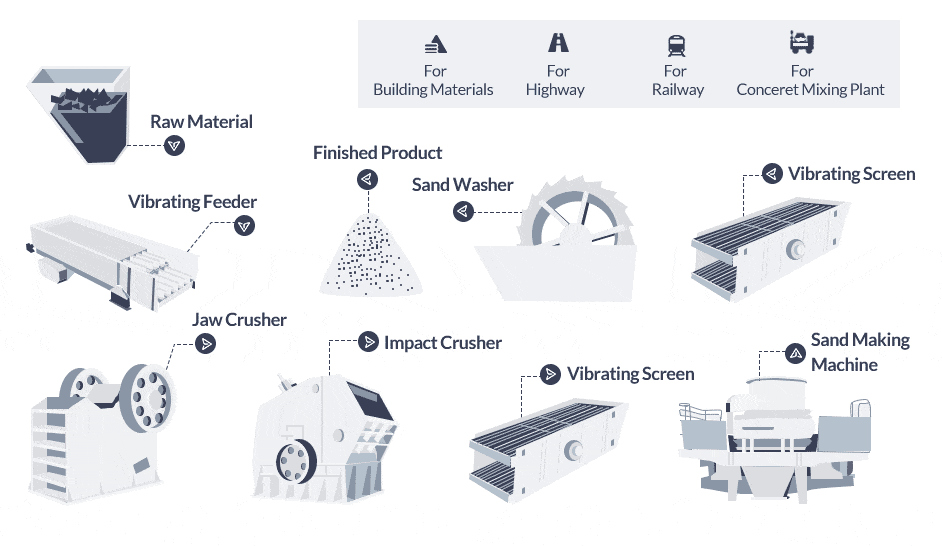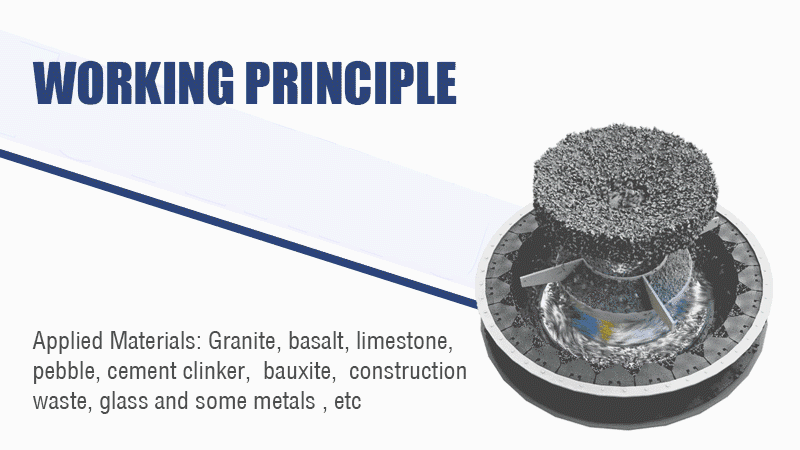Search the whole station Crushing Equipment
Sand making machine is suitable for soft or medium hard and very hard ore materials with hardness not higher than 320 Pa. Also. It has the characteristics of stable and reliable work, easy maintenance, and a high sand production rate.
The specific production capacity is based on the customer’s site configuration and actual production capacity.
A sand making machine, also known as a vertical shaft impact crusher, is a type of equipment used to crush or shape rocks into sand particles. Its main purpose is to produce well-shaped sand products that can be used as a substitute for natural sand. A VSI Crusher is a type of impact crusher that uses a high-speed rotor to throw rock against itself or against stationary anvils. The “Vertical Shaft” part of the name simply means the main shaft that spins the rotor is oriented vertically. It accelerates the material and uses the impact energy to create consistently shaped, cubical sand particles. This is different from a jaw or cone crusher, which uses compression.

You need a sand making machine to create high-quality sand when natural sources are unavailable, inconsistent, or too expensive. Natural sand often has impurities and poor particle shape. A VSI gives you complete control over the final product.
Many quarries have huge piles of surplus chips (e.g., 5-15mm rock) that are too small for road base and too large for sand. This “dead stock” is a liability. A VSI crusher takes that zero-value waste pile and converts it into high-quality manufactured sand, which often sells for more per ton than the quarry’s primary products. It turns a problem into a major profit center.
VSI crushers are generally classified by how the material is crushed inside the chamber. This choice is critical and depends on the final product you need to sell.
The industry often prefers “rock-on-rock” for its lower wear costs, but the choice should be based on the sand specification your customers demand, not just wear costs.
The versatility of the sand making machine makes it useful across many industries. You can find it anywhere high-quality sand or fine aggregate is needed.

Understanding the main parts of a VSI crusher helps with operation and maintenance.
The VSI crusher working principle is based on high-velocity impact.
However, an expert operator “tunes” the machine using the cascade feed. By blending the feed (e.g., 70% to the rotor, 30% to the cascade), you create a curtain of rock for the high-velocity particles to smash into. This maximizes efficient rock-on-rock collisions. Adjusting this ratio is like a fine-tuning knob for your sand’s shape and size, without even changing the rotor speed.
The sand making product line follows a systematic process. Here’s a clear and structured breakdown of the steps involved:
This process forms a closed loop where the materials go through repeated crushing and screening stages until they meet the desired size and quality requirements. The rock crusher equipment continues until the desired amount of sand is produced. By following this structured sand processing line, sand manufacturing machines efficiently crush, screen, wash, and refine raw materials to produce high-quality sand products. Let’s take a look at a real case.

The material falls vertically into the high-speed rotating impeller from the upper part of the machine. Under the action of high-speed centrifugal force, it will collide with another part of the material shunted around the impeller in the form of an umbrella. The material forms a vortex between the casings, collides and rubs each other many times, is crushed, and is directly discharged from the lower part to form a closed circuit for multiple cycles. After being controlled by the screening equipment, the finished product reaches the required particle size.
The sand-making machine is composed of seven parts: a feeding hopper, a distributor, a vortex crushing chamber, an impeller body, a main shaft assembly, a base, a transmission device, and a motor.

| Model | VSI-7611 | VSI-8518 | VSI-9526 | VSI-1140 | VSI-1145 | |
| Capacity (t/h) | Cascade and Center Feeding | 120-180 | 200-260 | 300-360 | 450-520 | 490-600 |
| Center Feeding | 60-90 | 100-130 | 150-190 | 225-260 | 250-310 | |
| Feeding Size (mm) | Soft Material | < 35 | < 40 | < 45 | < 50 | < 50 |
| Hard Material | < 30 | < 35 | < 40 | < 45 | < 45 | |
| Rotation Speed (r/min) | 1700-1890 | 1520-1690 | 1360-1510 | 1180-1310 | 1180-1280 | |
| Power of the Double Motors (kw) | 110-150 | 180-220 | 264-320 | 400-440 | 440-520 | |
| Overall dimension L*W*H (mm) | 3700*2150*2100 | 4140*2280*2425 | 4560*2447*2278 | 5000*2700*3300 | 5100*2790*3320 | |
| Power Source | 380v:50hz | |||||
| Vibrating Sensor | Inspection Scope:0.1-20mm/s, it can be adjusted continuously. | |||||
| Hydraulic Lubrication Station | Power of Double Oil Pump | 2×0.31kw | ||||
| Safety | Double oil pumps make sure supply of oil with; Stop automatically without oil flow or oil pressure; Water cooled; Heating start the motor in winter. | |||||
| Overall Dimension L*W*H (mm) | 820x520x1270 | |||||
| Power of Oil-Box Heater | 2kw | |||||
Jaw Crushers Applicable Material:Quartz, granite, basalt, limestone, river stone, marble, shale, iron ore, copper ore, gold ore etc. A Jaw crusher is mainly used for medium-sized crushing of various ores and…
Cone crusher is usually used as secondary or tertiary crushing stage. It is characterized by robust structure, excellent productivity and simple operation. Cone crusher is ideal for crushing different stone and ro…
Impact crusher excel in primary crushing of rock. Stationary and mobile plants are available. Replacement of wearing parts is simple due to the hydraulic folding of the housing components. A variety of models are available | Get the fre…
The vibrating feeder (vibratory feeder) is suitable for bulk and granular materials such as limestone, calcite, dolomite, barite, talc, gypsum. And also quartz stone, river pebble, granite, basalt, construction waste, iron ore, coal, slag, …
loading…
已经是到最后一篇内容了!
We use cookies to ensure that we give you the best experience on our website. If you continue to use this site we will assume that you are happy with it.
Privacy Policy